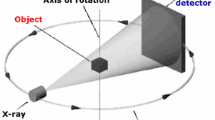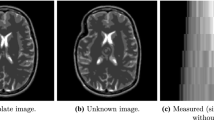Abstract
A new approach to maximum entropy tomographic image reconstruction is presented. It is shown that by using a finite-dimensional subspace, one can obtain an approximation to the solution of a maximum entropy optimization problem, set inL 2 D. An example of an appropriate finite element subspace for a two-dimensional parallel beam projection geometry is examined. Particular attention is paid to the case where the x-ray projection data are sparse. In the current work, this means that the number of projections is small (in practice, perhaps only 5–20). A priori information in the form of known maximum and minimum densities of the materials being scanned is built into the model. A penalty function, added to the entropy term, is used to control the residual error in meeting the projection measurements. The power of the technique is illustrated by a sparse data reconstruction and the resulting image is compared to those obtained by a conventional method.
Similar content being viewed by others
References
Altschuler, M. D., Chang, T., and Chu, A. (1978). Rapid Computer Generation of 3-D Phantoms and their Cone-Beam x-Ray Projections, Medical Image Processing Group Technical Report MIPG16, State University of New York at Buffalo.
Fletcher, R. (1980).Practical Methods of Optimization, Vol. 2, John Wiley, New York.
Gelfand, I. M., and Fomin, S. V. (1963).Calculus of Variations, Prentice Hall, Englewood Cliffs, New Jersey.
Gill, P., Murray, W., and Wright, M. (1981).Practical Optimization, Academic Press, London.
Klaus, M., and Smith, R. T. (1988). A Hillbert space approach to maximum entropy reconstruction,Math. Meth. Appl. Sci., to appear.
Levine, R. D., and Tribus, M. (1978).The Maximum Entropy Formalism, MIT Press, Cambridge.
Minerbo, G. (1979). MENT: a maximum entropy algorithm for reconstructing a source from projection data,Comp. Graph. Image Proc. 10, 48–68.
Murtaugh, B. A., and Saunders, M. A. (1978). Large-scale linearly constrained optimization,Math. Prog. 14, 41–72.
Smith, R. T., Zoltani, C. K., and Klem, G. J. (1988). Reconstruction of tomographic images from sparse data by a new finite element maximum entropy approach, submitted for publication.
Zoltani, C. K., White, K. J., and Kruger, R. P. (1983). Result of feasibility study on computer assisted tomography for ballistic applications, Technical Report, ARBRL-TR-02513, Aberdeen Proving Ground, Maryland.
Author information
Authors and Affiliations
Rights and permissions
About this article
Cite this article
Smith, R.T., Zoltani, C.K. An application of the finite element method to maximum entropy tomographic image reconstruction. J Sci Comput 2, 283–295 (1987). https://doi.org/10.1007/BF01061114
Received:
Issue Date:
DOI: https://doi.org/10.1007/BF01061114




